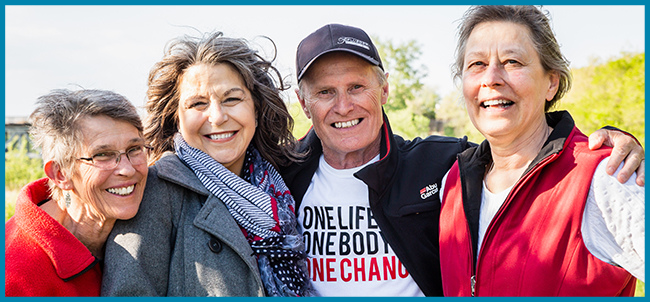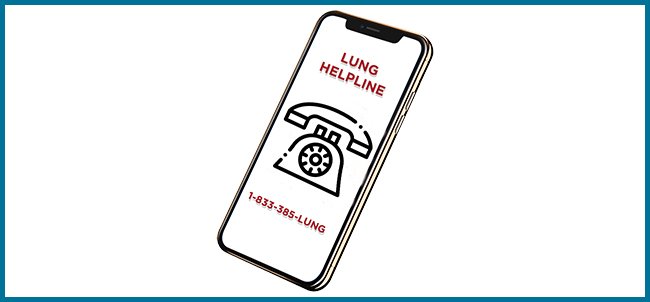Healthy Living With Lung Disease
Tobacco, Second-hand Smoke, and Vaping
If you have already quit smoking – congratulations!
If you smoke, today is a great day to quit smoking. Stopping smoking will not only prevent lung disease, but help you manage any existing lung disease. Remember DO NOT SMOKE WHILE USING OXYGEN. It is a dangerous fire hazard to smoke within 10 feet or 3 meters of oxygen equipment.
Exercise - Pulmonary Rehabilitation
Pulmonary rehabilitation is an exercise and educational program designed for people with lung disease. The program often includes, but is not limited to, aerobic training (walking, biking etc.), resistance or strength training (lifting weights or bands), flexibility exercises (stretches) and educational sessions about ways to best manage your disease. The programs usually include information on healthy living and nutrition. Pulmonary rehabilitation is also a way for people to meet and feel supported by others who have lung disease. It might not seem logical to take part in exercise especially if it makes you breathless, however staying active is a recommended part of managing pulmonary fibrosis.
Why Take Part in Pulmonary Rehabilitation?
- Exercise training has been proven to be a safe and effective way to prevent and to help manage chronic (long term) conditions.
- It can allow you to walk further, do more physical activity, improve or maintain muscle strength and increase your ability to do everyday tasks.
- You may have less shortness of breath.
- You will learn more about managing your disease.
- It will provide you with emotional and social support.
- It could improve your quality of life and help you to feel better all around.
Self-Care
Taking care of yourself and preventing colds and flus is also very important in managing your pulmonary fibrosis.
Self-Care Tips
- Ask your doctor about the flu (influenza), pneumonia (pneumococcal) and COVID-19 vaccinations.
- Wash your hands often and properly with soap.
- Try to avoid touching your mouth, nose or eyes.
- Try to stay clear of people who are ill with chest infections or colds.
- Stay as fit as you can. To find a pulmonary rehabilitation program near you visit Find a Pulmonary Rehab Program to download the Saskatchewan Pulmonary Rehab List.
- If you smoke, today is the best day to quit smoking.
Nutrition
Your body needs a lot of energy. People with severe lung disease use more energy breathing.
If you are underweight, you may lack energy. A health care provider may advise you to obtain more calories through a specific diet. If you are overweight, however, your muscles will have to work harder and this can worsen your shortness of breath. Excess weight around your waistline can make breathing even more difficult because it places more pressure on your diaphragm – which assists your lungs with breathing. A balanced and healthy diet can help you achieve a healthy weight.
Learn more about healthy eating.
- To learn more about nutrition for COPD and IPF watch the recorded webinar Nutrition Information with Dietitian and Certified Respiratory Educator Karen Davis.
- Pulmonary Fibrosis: To learn more about healthy living with pulmonary fibrosis visit Lung Health Materials to download and read Management in the IPF Handbook.
- COPD: To learn more about healthy living with COPD visit Lung Health Materials to download and read Management in the COPD Handbook.
Activities – Managing your Energy
As many lung diseases becomes more severe, there is often a decline in physical function. The majority of people first notice they are more short of breath than usual when they are exercising. However, eventually people you might find it is challenging to walk upstairs, shower, do house work, cook, clean, or get dressed. Putting a plan and supports in place to assist with these daily activities of living is key. This could include adjusting how you do things to save energy, working with local programs that can help bring you meals, have home care come into your home to help with some of your personal care, moving to a place that has assisted living or asking for help from a support person.
Pace and plan your tasks so you can conserve energy wherever you can. These can be simple changes to your routine like limiting the number of times you need to walk upstairs or sitting down while preparing supper.
Intimacy
Intimacy is something that can still be a part of your life. It is important to be honest with your partner and discuss your limitations as a result of shortness of breath and other symptoms. Plan to have sex when you are rested. Avoid eating a large meal or drinking a lot of alcohol beforehand, so you will not get breathless.
Your medications should not interfere with sexual function. If you have one, you may want to take a dose of your quick-relief medicine (bronchodilator) before sex to reduce breathlessness. Go slowly and use any sexual position that is comfortable and pleasurable for you and your partner.





